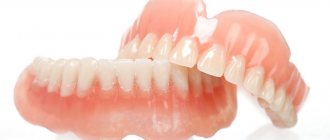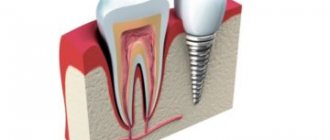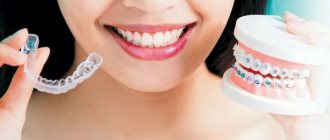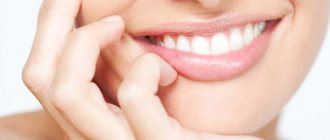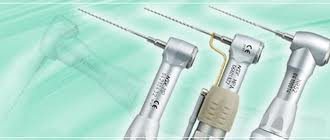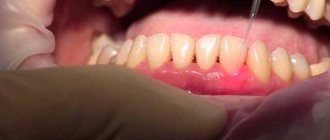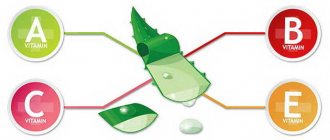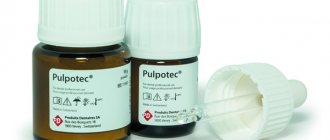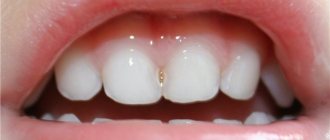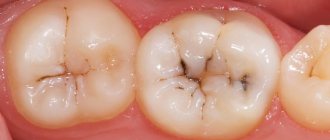Conservative methods of treating traumatic injuries of the jaw
Jaw fracture, how to treat this pathology in a conservative way?
Therapy for such patients is carried out according to the following scheme:
- Reposition . The movement of bone fragments to a physiological position is usually called reposition. Damaged areas of the jaws, as a rule, are combined simultaneously. If this fails, dentists move the fragments gradually using traction over the course of a day.
- Immobilization . At this stage, the doctor fixes the pre-matched bone fragments for 4-5 weeks. During this time, a bone callus forms in the fracture zone. With a bilateral fracture, the immobilization period often increases to 5-6 weeks.
- Drug therapy and physical procedures are aimed at preventing complications and accelerating recovery processes in bone tissue.
| Stages of treatment for jaw fractures | Clinical picture |
| Reposition |
|
| Immobilization |
|
| Drug therapy | Taking anti-inflammatory drugs |
| Physical procedures |
|
Treatment of jaw fractures always includes deciding on the advisability of preserving the teeth located in the area of the bone fracture.
Symptoms
Recognizing a fracture of the upper jaw is quite simple - a person immediately shows external signs. Most often, doctors adhere to the Le Fort classification, with the help of which it is possible to determine certain features of this condition.
Typically, a fracture of the upper jaw can be recognized by the following manifestations:
- When closing the oral cavity, acute pain occurs;
- Formation of hematomas, bruises;
- Displacement of the line of teeth, their divergence, changes in bite;
- Bleeding from the ears, nose, mouth;
- Swelling of the face;
- Unnatural jaw mobility;
- Changing the shape of the middle of the forehead.
Keep in mind that in some cases it is difficult to diagnose a fracture of the upper jaw - this condition does not always manifest itself with distinctive symptoms. This is an extremely dangerous condition that, in the absence of qualified treatment, can easily lead to serious negative consequences.
Often, people experience impaired functionality of internal organs due to compression of the brain and skull bones. Recognizing the symptoms is quite simple; manifestations depend on the classification.
The following features must be taken into account:
- When the jaw above the palatal vault is fractured, the maxillary sinuses break off. Often this condition also causes a broken nose. It can be recognized by severe swelling of the entire face. Excessive bleeding may occur.
- When the base of the upper jaw is fractured, a person experiences severe numbness around the eyes. This occurs due to a break in the line between the eye socket and the bridge of the nose. There is bleeding from the nose that cannot be stopped. Salivation also increases. A person's sense of smell completely disappears.
- When the jaw is torn away from the base of the skull, a serious decrease in visual acuity occurs and blurred vision occurs. The man cannot open his mouth. The face takes on an asymmetrical shape, with the eyes sloping downwards.
A jaw fracture occurs along with nausea, often accompanied by vomiting. The bite is significantly disturbed, the patient suffers from serious pain. All internal processes are also hampered - it is impossible to breathe normally. In almost all cases, a concussion occurs along with a fracture of the upper jaw.
It is very important to provide the patient with timely first aid. Anesthesia should be administered to alleviate the person’s condition. You should also try to stop the bleeding and restore breathing ability.
Main types of conservative immobilization
In dental practice, the following methods of temporary fixation of bone fragments are distinguished:
- extraoral techniques in the form of an improvised bandage from a bandage or other improvised means;
- intraoral techniques using intermaxillary ligature fastening.
Sling bandage for a fracture of the lower jaw
Permanent immobilization is carried out in the following ways:
- tires manufactured outside the laboratory (standard, metal tires);
- laboratory tires.
Transport immobilization of bone fragments
A jaw fracture, treated at home using temporary immobilization, is indicated in the following cases:
- inability to permanently fix the fracture and urgently transport the patient to a specialized dental department;
- lack of medical personnel capable of performing high-quality fixation of bone fragments;
- lack of time for constant splinting, which happens during natural disasters or in combat conditions;
- the patient’s serious condition caused by traumatic shock or traumatic brain injury, which is a relative contraindication to permanent immobilization.
Temporary stabilization of the position of bone fragments is carried out for a period of no more than 3-4 days. These activities are usually carried out by junior and nursing staff.
Dental surgeons point to the following extraoral methods of transport immobilization:
| Method of extraoral fracture fixation | Indications and procedure |
| Bandage parietal-chin bandage | The indications for such a bandage are fractures of the upper and lower jaw. For fixation, you can use a bandage or other auxiliary items. Such a bandage, as a rule, does not fit securely on the head and requires frequent correction. |
| This bandage is firmly fixed on the head and is used for all types of jaw bone fractures. |
| Soft Standard Chin Sling | This type of bandage consists of a standard chin sling, which is fixed to the patient's head using elastic bands. This sling is incredibly easy to use and allows you to fix even broken toothless jaws. |
| In such cases, the doctor installs a special cap with a chin sling for the victim. |
Experts often ask the question: “How is a jaw fracture treated using intraoral temporary immobilization?”
In such cases, dentists fix bone fragments using one of two methods:
- Standard splint for the upper jaw. This device consists of a cap and a metal spoon splint with external rods;
- Ligature articulation of the jaws. In clinical practice, specialists predominantly use this type of temporary immobilization. The jaws are fixed using a metal wire.
Ligature immobilization
The indication for intraoral ligature connection of bone fragments is a jaw fracture with displacement of bone fragments. Such patients can be safely transported to a specialized medical facility.
Immobilization of the jaws with a permanent dental splint
After determining the question: “Where to treat a jaw fracture?” the patient is often splinted in an inpatient department of maxillofacial dentistry. Such tires are made from aluminum wire with a diameter of up to 2 mm. Doctors model these devices individually.
The procedure is carried out in the following order:
- subcutaneous injection of atropine solution, which reduces saliva secretion;
- local anesthesia for the area of bone fracture;
- removal of tartar and soft plaque;
- holding a ligature through the interdental spaces and articulation of the upper and lower jaws.
Splinting a jaw fracture
Immobilization of bones using laboratory splints
Dental instructions state that laboratory-made splints are an orthopedic method of immobilization. This technique often serves as an adjunct to surgical treatment.
Laboratory intraoral splints
Indications for laboratory splinting:
- jaw fractures with significant bone damage when bone grafting is not possible;
- patients with severe chronic diseases (diabetes mellitus, stroke) who have contraindications to radical intervention;
- the patient’s independent refusal of surgical immobilization;
- the need for additional fixation of bone fragments along with the fixation of traditional wire splints.
Treatment of fractures of the upper jaw
Treatment of fractures of the upper jaw requires an integrated approach on the part of the attending physician and the patient. The type of therapy depends entirely on the pathological condition. The doctor needs to take into account the patient’s condition, the number of fractures, and fracture lines.
It is also necessary to assess the condition of the teeth – their stability, presence. They can place additional stress on the tires. If the fracture occurs exclusively in the alveolar process, then the doctor applies exclusively a sling-shaped bandage. This treatment is not enough, if there is a more serious injury, a Limberg splint is additionally applied.
Often a fracture is accompanied by complications. Due to the displaced bone fragments, the blood circulation process is significantly disrupted, and swelling of the meninges often occurs.
The greatest danger is posed by dysfunction of the respiratory system. Because of this, it is necessary to conduct extensive diagnostics to determine all existing problems. Only after this the doctor selects an individual course of treatment.
Treatment includes the following activities:
- Diagnosis of the damaged area;
- Preparation for mixing fragments;
- Direct reduction;
- Fixation of bone fragments;
- Continuous diagnostic examination;
- Restoration activities.
To make it easier for the surgeon to combine the fragments, they need to be separated from the soft tissue. They are carefully cut and then sewn together. If therapy of the alveolar process is carried out, then all therapeutic manipulations are carried out through a sublabial incision. In some cases, incisions near the eyes are necessary - this is done for type 2 fractures.
If a third type fracture occurs, then it is necessary to expose the nasal and zygomatic protrusions. Remember that the treatment of fractures of the upper jaw is a serious therapy that requires a responsible approach on the part of the attending physician.
Extraoral devices for treatment of jaw fractures
Correction of a jaw fracture, which is treated extraorally, is carried out by two main devices:
- Static devices. These devices are indicated for fixation of linear and comminuted fractures of the mandible. The device has special bone clamps that are designed to fix bone fragments.
- Dynamic devices. In such cases, the patient is fitted with two knitting needles, which are connected by an external compression arc.
Extraoral dynamic device for fixation of bone fragments
Antibacterial therapy for patients with jaw fractures
Dentists indicate that the use of antibacterial agents for traumatic injuries
In dentistry, there are the following indications for taking anti-inflammatory drugs:
- traumatic swelling of soft tissues in the fracture area;
- gradual increase in signs of infiltration;
- increase in body temperature;
- increased pain syndrome;
- general intoxication of the body.
If the patient’s symptoms gradually disappear after 3-4 days from an acute injury, then the use of antibacterial agents should be discontinued.
In dental practice, when signs of inflammatory damage to the fracture zone increase, the patient is recommended to take broad-spectrum antibiotics, which are combined with sulfonamide medications. Correction of such therapy is carried out after determining individual sensitivity to the antibacterial drug.
Broad-spectrum antibiotics
The most effective means of conservative treatment are: lincomycin, tetracycline, oxytetracycline and vibramycin. These medications have the ability to be highly concentrated in the bone tissue of the jaws.
In parallel with antibiotics, doctors prescribe detoxification therapy in the form of intravenous drips. The price of treatment will depend on the severity of the patient’s condition and the type of pharmacological agent.
Symptomatic treatment of patients with fractures of the lower or upper jaw is reduced to taking desensitizing and antipyretic medications. At the local level, specialists perform novocaine blockades of the area of bone tissue damage.
